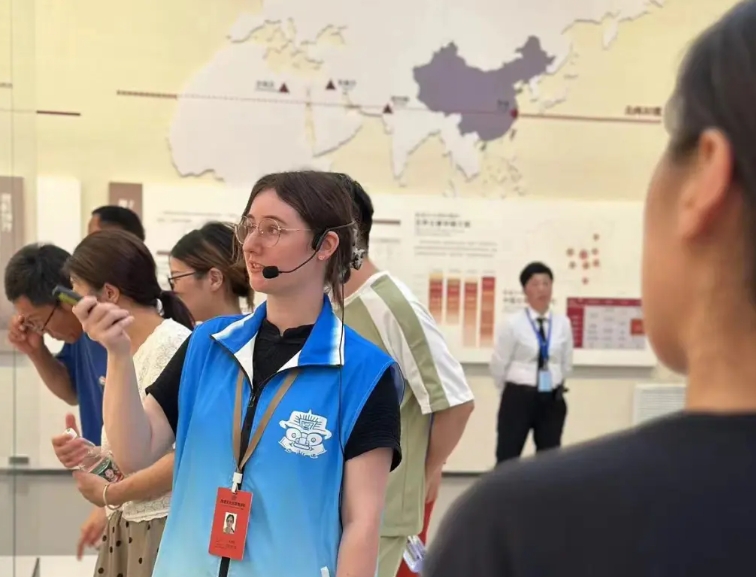"If I don't express this now, I feel as if I'm on the verge of exploding," exclaimed Emma Chen. Her attire was adorned with replicas of the bronze sacred tree from the Sanxingdui culture of the Shang Dynasty. From her ears dangled ancient jade bi disk-shaped earrings (one of China's traditional ritual objects or ornaments), and her canvas bag was decorated with intricate patterns from the Liangzhu Museum.
Emma is a walking embodiment of her profound love for history. As a native of Yorktown, Indiana, USA, she has developed a profound passion for Chinese history, one that propelled her across the Pacific Ocean. She has crafted a unique bridge between antiquity and modernity, as well as the East and the West. Her story is a blend of personal growth and cultural exploration that has transformed her from a self-described "Shekong"(Chinese for introvert) to a bilingual volunteer docent at the Liangzhu Museum.
"I want you guys to guess three things that are real." In the halls of the Liangzhu Museum, Emma challenged the audience with a mischievous smile. Promptly, a spectator spotted a wooden well and exclaimed, "This can't be authentic. Being made of wood and serving as a well, it would have decayed long ago due to constant human interaction." Emma's grin broadened as she revealed, "That's one of the real ones. This is something really interesting: we can learn about archaeology in that objects submerged underwater are often better preserved." With their eyes widening in surprise, the visitors gathered around the wooden well to scrutinize it intently. Emma then began her absorbing description of the lifestyle of the ancient Liangzhu people surrounding the well.
This is merely one of Emma's many artful techniques of explaining, which are not merely informative but also highly engaging. As a volunteer docent fluent in both Chinese and English, she tends to bring history to life and transforms artifacts into stories accessible to her audience.
Yet, for all her confidence on the stage of the museum, Emma confessed to a quieter battle within. When speaking with strangers, her cheeks would flush, her words would become sparse, and her voice would tremble like a delicate leaf in the wind. But with each step into the museum, she transforms, her confidence blossoming like a lotus emerging from still waters, her voice steadying to narrate the stories of artifacts with the ease of a master storyteller.
"When I'm guiding, I feel very comfortable and enjoy the process. I've read numerous books and seen many museums in China, and I'm eager to share what I've learned with others," she said.
Emma's fascination with Chinese history was a personal odyssey, sparked by curiosity about Asian culture. It was a journey that led her across the Pacific, not as a tourist, but as a pilgrim seeking wisdom in ancient texts. Her love for Chinese history is more personal than academic.
Drawn to the era's spirit of individuality and autonomy, Emma admires the Weijin Southern and Northern Dynasties (420–589). She recounted an example from "Shishuo Xinyu" (also known as A New Account of the Tales of the World, a historical compilation of anecdotes about Chinese scholars, musicians, and artists during the 2nd-4th centuries) about Cao Pi, the Cao Wei Dynasty founder, who led a group to mimic donkeys at Wang Can's mourning hall, expressing their grief and respect for his humorous friend who loved donkey's voice. "Imagine a group of people imitating donkeys—it's amusing," she added, "these behaviors may seem strange, but I believe they reflect their true nature and emotions."
Emma also cherishes the phrase from "Shishuo Xinyu": "I have dealt with and known myself long, and I'd rather be true to who I am," as it emphasizes independence and the quest for inner freedom, echoing Emma's own narrative of self-exploration and authenticity.
Her story is not just about the past; it's about the present and the future. Emma is determined to continue her studies, aiming for a master's degree and perhaps even a doctorate. Despite attaining a high proficiency in Chinese, reaching the HSK5 level, she remains unwavering in her commitment to studying at Chinese Surfing, a Chinese language school. Emma knows precisely what she wants to accomplish and is prepared to face the challenges that lie ahead. Her ultimate goal is to become a professional in her field, to impart her knowledge precisely, and to continue her role as a bridge between cultures.
As Emma stood amidst the relics of the past, her silhouette was framed by the light of the Liangzhu Museum, casting her in a glow. When you step into the museum, make sure to find Emma and dive into her captivating guidance!

